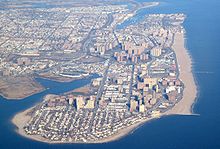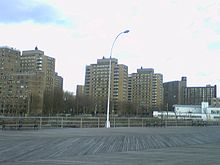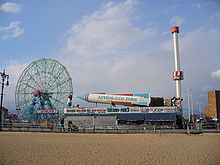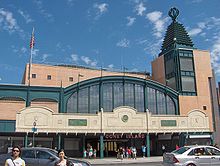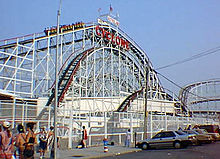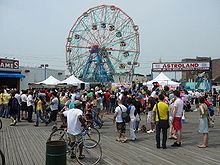- Coney Island
-
For other uses, see Coney Island (disambiguation).
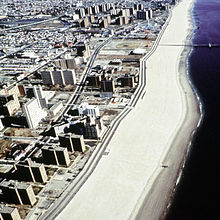 Aerial view of the beach at Coney Island[1]
Aerial view of the beach at Coney Island[1]
Coney Island is a peninsula and beach on the Atlantic Ocean in southern Brooklyn, New York, United States. The site was formerly an outer barrier island, but became partially connected to the mainland by landfill.
Coney Island is possibly best known as the site of amusement parks and a major resort that reached their peak during the first half of the 20th century. It declined in popularity after World War II and endured years of neglect. In recent years, the area has seen the opening of MCU Park and has become home to the minor league baseball team the Brooklyn Cyclones.
The neighborhood of the same name is a community of 60,000 people in the western part of the peninsula, with Sea Gate to its west, Brighton Beach and Manhattan Beach to its east, and Gravesend to the north.
Contents
Geography
Coney Island is the westernmost part of the barrier islands of Long Island, about 4 miles (6.4 km) long and 0.5 miles (0.80 km) wide. Formerly it was an island, separated from the main part of Brooklyn by Coney Island Creek, which was partially tidal mudflats, but it has since been developed into a peninsula. There were plans early in the 20th century to dredge and straighten the creek as a ship canal, but they were abandoned, and the center of the creek was filled in for construction of the Belt Parkway before World War II. The western and eastern ends are now peninsulas.
History
Etymology
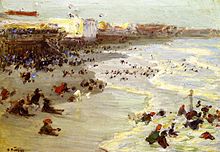 Coney Island, c. 1914, by Edward Henry Potthast
Coney Island, c. 1914, by Edward Henry Potthast
The Native American inhabitants of the region, the Lenape, called the island Narrioch—meaning "land without shadows"—because, as with other south shore Long Island beaches, its orientation means the beach remains in sunlight all day.[citation needed]
Following European settlement, New York State and New York City were originally a Dutch colony and settlement, named Nieuw Nederland and Nieuw Amsterdam. The Dutch name for the island—originally Conyne Eylandt, or Konijneneiland in modern Dutch spelling[2]—probably precedes the similar English name, Coney Island, with both translating as "Rabbit Island".[3] As on other Long Island barrier islands, Coney Island had many and diverse rabbits, and rabbit hunting prospered until resort development eliminated their habitat. The Dutch name is found on the New Netherland map of 1639 by Johannes Vingboon, which is before any known English records.[4]
Coney Island therefore appears to be the English adaptation of the Dutch name. The word "coney" was popular in English at the time as an alternative for rabbit; while coney survives in archaic and dialectal contexts, a later adaptation, "bunny", is now in common use. Coney came into the English language through the Old French word conil, which itself derived from the Latin word for rabbit, cuniculus. The English name "Conney Isle" appeared on maps as early as 1690,[5] and by 1733 the modern name, Coney Island, was used.[6] Joseph DesBarre's chart of New York harbor in the 1779 work Atlantic Neptune,[7] and John Eddy's map of 1811, both use the modern spelling.[8]
Although the history of Coney Island's name and its anglicization can be traced through historical maps spanning the 17th century to the present,[9] and all the names translate to Rabbit Island in modern English, there are still those who contend that the name derives from other sources.[who?] Also possible is the Irish Gaelic name for Rabbit which is Coinín, which is also anglicised to Coney. Ireland has many islands named Coney Island, all of which predate this one. Some claim that an Irish captain named Peter O'Connor named Coney Island in the 18th century, after an island in County Sligo known as both Coney Island and Inishmulclohy. Another purported origin is from the name of the Indian tribe, the Konoh, who supposedly once inhabited it. A further claim is that the island is named after Henry Hudson's right-hand-man, John Coleman, supposed to have been slain by Indians.[10]
Resort
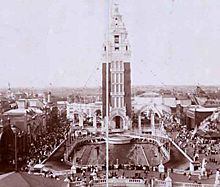 Dreamland tower and lagoon in 1907
Dreamland tower and lagoon in 1907
Due to Coney Island's location—easily reached from Manhattan and other boroughs of New York City, yet distant enough to suggest a proper vacation—it began attracting holidaymakers in the 1830s and 1840s, when carriage roads and steamship services reduced travel time from a half-day journey to just two hours.[11]
The original Coney Island Hotel was constructed in 1829, with The Brighton Hotel, Manhattan Beach Hotel, and Oriental Hotel opening soon after, with each trying to provide an increasing level of elegance. Coney Island became a major resort destination after the American Civil War, as excursion railroads and the Coney Island & Brooklyn Railroad streetcar line reached the area in the 1860s, and the Iron steamboat company arrived in 1881. The two Iron Piers served as docks for the steamboats until they were destroyed in the 1911 Dreamland fire.
When the Brooklyn Rapid Transit Company electrified the steam railroads and connected Brooklyn to Manhattan via the Brooklyn Bridge at the beginning of the 20th century, Coney Island soon turned from a resort to a location accessible to day-trippers from New York City, especially those escaping the summer heat.[citation needed]
Charles I. D. Looff, a Danish woodcarver, built the first carousel at Coney Island in 1876. It was installed at Vandeveer's bath-house complex at West 6th Street and Surf Avenue, which later became known as Balmer's Pavilion. The carousel consisted of hand-carved horses and animals standing two abreast, with a drummer and a flute player providing the music. A tent-top provided protection from the weather. The fare was five cents.[citation needed]
From 1885 to 1896, the Coney Island Elephant was the first sight to greet immigrants arriving in New York, who would see it before the Statue of Liberty became visible.
In 1915 the Sea Beach Line was upgraded to a subway line. This was followed by upgrades to the other former excursion roads, and the opening of the New West End Terminal in 1919, thus ushering in Coney Island's busiest era.[12]
Nathan's Famous original hot dog stand opened on Coney Island in 1916 and quickly became a landmark. An annual Nathan's Hot Dog Eating Contest has been held there annually on July 4 since its opening, but has only attracted broad attention and television coverage since the late 1990s.[citation needed]
After World War II, contraction began seriously from a number of pressures. Air conditioning in movie theaters and then in homes, along with the advent of automobiles which provided access to the less crowded and more appealing Long Island state parks, especially Jones Beach State Park, lessened the attractions of Coney's beaches. Luna Park closed in 1946 after a series of fires, and the New York street gang problems of the 1950s spilled into Coney Island. The presence of threatening youths did not impact the beach-goers, but discouraged visitors to the rides and concessions which were staples of the Coney Island economy. The local economy was dealt a severe blow by the 1964 closing of Steeplechase Park, the last of the major amusement parks.[citation needed]
Development
Main article: Coney Island DevelopmentDevelopment on Coney Island has always been controversial. When the first structures were built around the 1840s, there was an outcry to prevent any development on the island and preserve it as a natural park. Starting in the early 20th century, the City of New York made efforts to condemn all buildings and piers built south of Surf Avenue, with the local amusement community opposing the city. Eventually a settlement was reached where the beach was declared as not beginning until 1,000 ft (300 m) south of Surf Avenue, the territory marked by a city-owned boardwalk, while the city would demolish any structures that had been built over public streets in order to reclaim beach access.[citation needed]
In 1944, Robert Moses actively opposed the "tawdry" entertainment at Coney Island and discouraged the building of new amusements. By 1949, Moses moved the boardwalk back from the beach several yards, demolishing many structures, including the city's municipal bath house. He would later demolish several blocks of amusements to clear land for both the New York Aquarium, where Dreamland once stood, and the Abe Stark Ice Skating Rink. In 1953, Moses had the entire island rezoned for residential use only, and announced plans to demolish the amusements to make room for low income housing. After public complaints, the Estimate Board reinstated some areas as protected for amusement use only, leading to many public land battles.[citation needed]
In 1964, Coney Island's last remaining large theme park, Steeplechase Park, closed and the property was sold to developer Fred Trump. Trump wanted to build luxury apartments on the old Steeplechase property and spent ten years battling in court to get the property rezoned. After a decade of court battles, Trump exhausted his legal options and the property remained zoned for amusements. He eventually leased the property to Norman Kaufman, who ran a small collection of fairground amusements on a corner of the site, calling his amusement park Steeplechase Park.[citation needed] However, between the loss of both Luna Park and the original Steeplechase Park, as well as an urban-renewal plan that took place in the surrounding neighborhood, involving middle class houses being replaced with low income housing projects, fewer visitors came to Coney Island. In the late 1970s the city proposed a plan to revitalize Coney Island by bringing in gambling casinos, as had been done in Atlantic City, but gambling was never legalized for Coney Island, and the area ended up with vacant lots.[citation needed]
In 1994 Rudy Giuliani took office as mayor of New York, and supported a plan to build a sporting complex named Sportsplex, provided it include a stadium for a minor league baseball team owned by the New York Mets. Once the stadium was completed Giuliani reneged on the Sportsplex deal, and The Mets decided to call the minor league team the Brooklyn Cyclones and sold the naming rights to the stadium to Keyspan Energy. Executives from Keyspan complained that the stadium's line of view from the rest of the Coney Island amusement area was blocked by the derelict Thunderbolt roller-coaster, and the following month Giuliani ordered an early-morning bulldozing of the Thunderbolt.[citation needed]
In 2003, Mayor Michael Bloomberg took an interest in revitalizing Coney Island as a possible site for the 2012 Olympics. When the city lost the bid for the Olympics, revitalization plans were rolled over to the Coney Island Development Corporation (CIDC), which came up with a plan to restore the resort. Shortly before the CIDC's plans were released, a development company, Thor Equities, purchased all of Bullard's western property, sold it to Taconic Investment Partners, and used much of the proceeds to purchase or offer to purchase every piece of property inside the traditional amusement area. In September 2005, Thor went public with a plans to build a large Bellagio-style hotel resort surrounded by rides and amusements. Plans of the hotel showed it covering the entire amusement area from the Aquarium to beyond MCU Park, and requiring the demolition of The Wonder Wheel, Cyclone, and Nathan's original hot dog stand, as well as the new MCU Park.[citation needed]
Late in 2006 Thor purchased Coney Island's last remaining amusement park, Astroland, and announced plans to close it after the 2007 season and build a Nickelodeon-themed hotel on the site. In January 2007 Thor released plans for a new amusement park to be built on the Astroland site called Coney Island Park.[13] In late 2007 Thor began to evict businesses from the buildings it owned along the boardwalk, but when one of the business owners complained, Thor reinstated their leases.[citation needed]
In early 2007, the Municipal Art Society launched the initiative ImagineConey,[14] as discussion of a rezoning plan that highly favored housing and hotels began circulating from the Department of City Planning.[15] City Planning certified the rezoning plan in January 2009. As of 2010 the plan was going through the Uniform Land Use Review Procedure (ULURP) process,[16] with Thor Equities saying it hoped to complete the project by 2011.[17] The Coney Island Aquarium was also planning a renovation from the mid-2000s.[18] In June 2009, the city's planning commission unanimously approved the construction of 4,500 units of housing and 900 affordable units, and vowed to "preserve, in perpetuity, the open amusement area rides that everyone knows and loves", while protesters argued that the "20 percent affordable-housing component is unreasonably low."[19]
Demographics
As of the 2000 census, there were 51,205 people living in Coney Island. Of those people, 29.3% were Black or African American, 51.2% were White, 18% were Hispanic or Latino, 3.8% were Asian, 0.5% were Native American, 0.1% were Pacific Islander, 7.6% were some other race, and 3.7% described themselves as two or more races. 70.5% had a high school degree or higher, and 20.7% had a bachelor's degree or higher. The median household income as of 1999 was $21,281.
Communities
The neighborhoods on Coney Island, from west to east, are Sea Gate, Coney Island proper, Brighton Beach, and Manhattan Beach. Sea Gate is a private community, one of only a handful of neighborhoods in New York City where the streets are owned by the residents and not the city; Sea Gate and the Breezy Point Cooperative are the only city neighborhoods cordoned off by a fence and gate houses.
The majority of Coney Island's population resides in approximately thirty 18- to 24-storey towers, mostly various forms of public housing. In between the towers are many blocks that were filled with vacant and burned out buildings. Since the 1990s there has been steady revitalization of the area. Many townhouses were built on empty lots, popular franchises opened, and Keyspan Park was built to serve as the home for the Brooklyn Cyclones baseball team. Once home to many Jewish residents, Coney Island's main population groups today are African American, Italian American, Hispanic, and recent Russian and Ukrainian immigrants.
Education
Coney Island is served by the New York City Department of Education. The Coney Island neighborhood is zoned to PS 90 for K-5 education[20] and IS 303 Herbert S. Eisenberg for Grades 6-8[21] PS/IS 288 The Shirley Tanyhill School (Pre-K-8), PS 329 (K-5), PS 188 The Michael E. Berdy School (K-5), PS 100 (K-5), and Mark Twain (6-8) are all schools located in the heart of Coney Island. There are no zoned high schools.
Nearby high schools include:
- Abraham Lincoln High School
- John Dewey High School
- The Leon M. Goldstein High School for the Sciences
- Rachel Carson's School of Coastal Studies
- William E. Grady Vocational High School
- The High School Of Sports Management
Transportation
See also: Transportation to Coney IslandConey Island's main subway station is called Coney Island – Stillwell Avenue and is served by the D F N Q trains of the New York City Subway. The terminal is the largest elevated metro station in North America, with eight tracks serving the four services that use the station. The entire station was rebuilt in 2002–04, modernizing it with a large solar-panel canopy covering all eight tracks.
There is a bus terminal beneath the station. The buses that terminate there are the B68 to Prospect Park, the B74 to the Coney Island-Sea Gate border at West 37th Street via Mermaid Avenue, and the B82 to Starett City. The B36 runs from the Coney Island-Sea Gate border at West 37th Street to Nostrand Avenue at Avenue U in Sheepshead Bay, Brooklyn. The X28 provides an express service to Manhattan.
The three main avenues in the Coney Island community, are, from north to south, Neptune Avenue (which crosses to the mainland to become Emmons Avenue), Mermaid Avenue, and Surf Avenue (which becomes Ocean Parkway and then runs north towards Brooklyn's Prospect Park). The cross streets in the Coney Island neighborhood proper are numbered with "West" prepended to their numbers, running from West 1st Street to West 37th Street at the border of Sea Gate.
Amusement parks
Coney Island footage from the 1940s
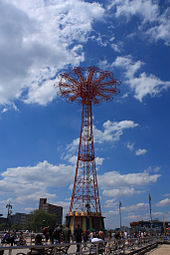 The Parachute Jump above the Coney Island boardwalk
The Parachute Jump above the Coney Island boardwalk
Between about 1880 and World War II, Coney Island was the largest amusement area in the United States, attracting several million visitors per year. At its height it contained three competing major amusement parks, Luna Park, Dreamland, and Steeplechase Park, as well as many independent amusements.
Astroland served as a major amusement park from 1962 to 2008,[22] and was replaced by a new incarnation of Dreamland in 2009 and of Luna Park in 2010. The other parks and attractions include Deno's Wonder Wheel Amusement Park, 12th Street Amusements, and Kiddie Park, while the Eldorado Arcade has an indoor bumper car ride. The Zipper and Spider on 12th Street were closed permanently on September 4, 2007, and dismantling began after its owner lost his lease. They are to be reassembled at an amusement park in Honduras.[23]
On April 20, 2011, the first new roller coasters to be built at Coney Island in eighty years were opened as part of efforts to reverse the decline of the amusement area.[24]
Rides
The amusement area currently contains various rides, games such as skeeball and ball tossing, and a sideshow including games of shooting, throwing, and tossing skills.
The rides and other amusements at Coney Island are owned and managed by several different companies, and operate independently of each other. It is not possible to purchase season tickets to the attractions in the area. Three rides at Coney Island are protected as designated New York City landmarks and are listed in the National Register of Historic Places. These three rides are:
- Wonder Wheel – built in 1918 and opened in 1920, this steel Ferris wheel has both stationary cars and rocking cars that slide along a track. It holds 144 riders, stands 150 ft (46 m) tall, and weighs over 2,000 tons. At night the Wonder Wheel's steel frame is outlined and illuminated by neon tubes.[25] It is located at Deno's Wonder Wheel Amusement Park.
- The Cyclone roller coaster – built in 1927, it is one of the United States's oldest wooden coasters still in operation. Popular with roller coaster aficionados, the Cyclone includes an 85 ft (26 m), sixty degree drop. It is owned by the City of New York, and was operated by Astroland, under a franchise agreement. It is located across the street from Astroland.
- Parachute Jump – originally built as the Life Savers Parachute Jump at the 1939 New York World's Fair, this was the first ride of its kind. Patrons were hoisted 190 ft (58 m) in the air before being allowed to drop using guy-wired parachutes. Although the ride has been closed since 1968, it remains a Coney Island landmark, and is sometimes referred to as Brooklyn's Eiffel Tower. Between 2002 and 2004, it was completely dismantled, cleaned, painted and restored, but remains inactive. After an official lighting ceremony in July 2006, the Parachute Jump was slated to be lit year round using different color motifs to represent the seasons. However, this idea was scrapped when New York City started conserving electricity in the summer months, and it has not been lit regularly since.
Other notable attractions include the following:
- B&B Carousell [sic] (as spelt by the frame's builder, William F. Mangels) – this is Coney Island's last traditional carousel, near the old entrance to Luna Park, but now surrounded by furniture stores. The carousel is faster than usual, with a traditional roll-operated fairground organ. When the long-term operator died unexpectedly, the carousel was put up for auction, with fears that it would leave Coney Island or be broken up for sale to collectors. However, the City of New York bought the B&B Carousell a few days before the auction; it has since been dismantled, with plans to operate it again in Coney Island, but the specific location remains to be determined. All the other carousels on Coney Island are kiddie park-style.
- Bumper cars – there are three separate bumper car rides on Coney Island, located in Astroland, Deno's Wonder Wheel Park, and Eldorado's Arcade on Surf Avenue.
- Haunted houses – three traditional dark ride haunted houses operate at Coney Island, Dante's Inferno at Astroland, Spook-a-Rama at Deno's, and the independent Ghost Hole.
Rides of the past
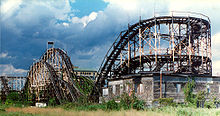 The Thunderbolt, as of 1995
The Thunderbolt, as of 1995
- Thunderbolt – this roller coaster across the street from Steeplechase Park was constructed in 1925 and closed in 1983. It was torn down by the city "to protect public safety" in 2000 during the construction of nearby Keyspan Park. In the Woody Allen movie Annie Hall, Allen's character's family lives in the small house-like structure under the rear of the roller coaster track.
- Tornado – this roller coaster was constructed in 1926. It suffered a series of small fires which made the structure unstable, and was torn down in 1977.
- Steeplechase Horse Race – created by a Coney Island resident George C. Tilyou in 1897, this ride consisted of people riding wooden horses around the park on a steel track.[26]
- Waterboarding Thrill Ride - in 2008 conceptual artist Steve Powers installed an anamitronics display of a captive being subjected to waterboarding. The ride triggered comment around the world.
Other venues
The New York Aquarium, which opened in 1957 on the former site of the Dreamland amusement park, is an attraction on Coney Island. In 2001, KeySpan Park opened on the former site of Steeplechase Park to host the Brooklyn Cyclones minor league baseball team.
Beach
Coney Island maintains a broad sandy beach from West 37th Street at Sea Gate, through the central Coney Island area and Brighton Beach, to the beginning of the community of Manhattan Beach, a distance of approximately 2.5 mi (4.0 km). The beach is continuous, and is served for its entire length by the broad Riegelmann Boardwalk. A number of amusements are directly accessible from the land-side of the boardwalk, as is the aquarium, and a variety of food shops and arcades.
The beach is groomed and replenished on a regular basis by the city. The position of the beach and lack of significant obstructions means virtually the entire beach is in sunlight all day. The beach is open to all without restriction, and there is no charge for use. The beach area is divided into "bays", areas of beach delineated by rock jetties, which moderate erosion and the force of ocean waves.[citation needed]
The Coney Island Polar Bear Club consists of a group of people who swim at Coney Island throughout the winter months, most notably on New Year's Day, when additional participants join them to swim in the frigid waters.[27]
Coney Island beach serves as the training grounds for the Coney Island Brighton Beach Open Water Swimmers (CIBBOWS),[28] a group dedicated to promoting open water swimming for individuals of all levels. CIBBOWS hosts several open water swim races each year, such as Grimaldo's Mile and the New York Aquarium 5k, as well as regular weekend training swims.[28]
Other events
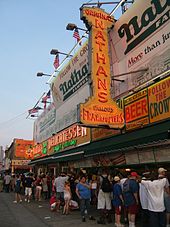 Nathan's Famous at Coney Island
Nathan's Famous at Coney Island
The Coney Island Mermaid Parade takes place on Surf Avenue and the boardwalk, and features floats and various acts. It has been produced annually by Coney Island USA, a non-profit arts organization established in 1979, dedicated to preserving the dignity of American popular culture.
Coney Island USA has also sponsored the Coney Island Film Festival every October since 2000,[29] as well as Burlesque At The Beach, and Creepshow at the Freakshow (an interactive Halloween-themed event). It also houses the Coney Island Museum.
The annual Cosme 5K Charity Run/Walk, supported by the Coney Island Sports Foundation (CISF), takes place on the last Sunday of June on the Riegelmann Boardwalk.
In August 2006 Coney Island hosted a major national volleyball tournament sponsored by the Association of Volleyball Professionals. The tournament, usually held on the west coast of the United States, was televised live on NBC. The league built a 4,000-seat stadium and twelve outer courts next to the boardwalk for the event.[citation needed] The tournament returned to Coney Island in 2007 and 2008.
In April 2009, Feld Entertainment, parent company to Ringling Bros. and Barnum & Bailey Circus, announced that "The Greatest Show on Earth" would perform on Coney Island for the entire summer of 2009, the first time since July 16, 1956 that Ringling Bros. had performed in this location. The tents were located between the boardwalk and Surf Avenue, and the show was called The Coney Island Boom-A-Ring. In 2010, they returned to the same location with The Coney Island Illuscination.[citation needed]
Amusement parks in the literature
Many characters of O. Henry's short stories visit amusement parks on Coney Island.
In entertainment
Main article: Coney Island in popular cultureConey Island is the setting of Andrew Lloyd Webber's musical Love Never Dies, the sequel to The Phantom of the Opera. It is also the centre of Frederick Forsyth's novel, The Phantom of Manhattan, which was part of the basis for Webber's production.[citation needed], In the Penguins of Madagascar series, Coney Island played location of Dr. Blowhole's secret lair in Dr. Blowhole's Revenge as Kowalski had said, smelling a fake King Julien, "Salty Atlantic sea air, Roller coaster grease and all beef wieners, with mustard," and Skipper translated it to Coney Island.
References
- ^ This photograph was taken prior to 1995, as indicated by the fact that MCU Park does not appear to the left of the Parachute Jump, and the Half Moon Hotel (the U-shaped building just below the photo's center) is still standing.
- ^ Joan Vinckeboons (Johannes Vingboon), "Manatvs gelegen op de Noot Riuier", 1639. Coney Island is labelled "Conyne Eylandt". Image of Vinckeboons map at Library of Congress.
- ^ Library of Congress New Netherland website lists Conyne Eylandt as Dutch name for Coney Island.
- ^ "De Nieu Nederlandse Marcurius", Volume 16, No. 1: February 2000. This is the newsletter of the New Netherland Project. Cites New Netherland map labeling "Conyne Eylandt" in 1639 Johannes Vingboon map.
- ^ Robert Morden, "A Map of ye English Empire in the Continent of America", 1690. Coney Island is labelled "Conney Isle". Image of Morden map at SUNY Stony Brook.
- ^ Henry Popple, "A Map of the British Empire in America", Sheet 12, 1733. Coney Island is labelled "Coney Island". Image of Popple Map can be found at David Rumsey Map Collection
- ^ Illustrated in Eric W. Sanderson, (2009). Mannahatta: A Natural History of New York City p. 47; in 1779 the island was a cluster of three low hummocks in the shallow "East Bank" flats at the eastern end of Gravesend Bay.
- ^ John H. Eddy, "Map Of The Country Thirty Miles Round the City of New York", 1811. Coney Island is labeled "Coney I." Image of Eddy Map can be found at David Rumsey Map Collection.
- ^ Refer to maps given above.
- ^ Coney Island Gets a Name
- ^ "Decadence by the Sea, Coney Island in the Nineteenth Century", Google books
- ^ Matus, Paul. "The New BMT Coney Island Terminal". The Third Rail Online. http://thethirdrail.net/0305/stillwell4.html. Retrieved 2007-08-29.
- ^ Lombino, David (November 13, 2006). "A $1.5 Billion Vision For Coney Island". The New York Sun. http://www.nysun.com/new-york/15-billion-vision-for-coney-island/43372/. Retrieved 2010-08-05.
- ^ "Imagineconey: an initiative by the Municipal Art Society to develop bold new ideas for Coney Island". Imagineconey. http://imagineconey.com. Retrieved 2010-03-17.
- ^ "New York City Department of City Planning - Amanda M. Burden, Director". Nyc.gov. 2010-03-04. http://www.nyc.gov/html/dcp/home.html. Retrieved 2010-03-17.
- ^ "Uniform Land Use Review Procedure (ULURP) - New York City Department of City Planning". Nyc.gov. http://www.nyc.gov/html/dcp/html/luproc/ulpro.shtml. Retrieved 2010-03-17.
- ^ Levitt, David M.; Ivry, Bob (November 28, 2006). "Coney Island's Astroland Sold, Will Close Next Year". Bloomberg News. http://www.bloomberg.com/apps/news?pid=newsarchive&sid=aAUnFAdku_FA. Retrieved 2010-08-05.
- ^ Ramirez, Jeanine (November 14, 2006). "Plans Coming Together For Coney Island Amusement Park Expansion". NY1. http://www.ny1.com/?SecID=1000&ArID=64315. Retrieved 2010-08-05.
- ^ Edroso, Roy (June 17, 2009). "Planning Commission Approves Unloved Coney Plan". The Village Voice. http://blogs.villagevoice.com/runninscared/archives/2009/06/planning_commis.php. Retrieved 2010-08-05.
- ^ PS 90, New York City Schools portal
- ^ IS 303 Herbert S. Eisenberg, New York City Schools portal.
- ^ "Coney Island amusement park closing: News & Videos about Coney Island amusement park closing - CNN iReport". Ireport.com. http://www.ireport.com/ir-topic-stories.jspa?topicId=22385. Retrieved 2010-03-17.
- ^ Calder, Rich (September 5, 2007). "Ride Over for Coney Classics". New York Post. http://www.nypost.com/seven/09052007/news/regionalnews/ride_over_for_coney_classics.htm. Retrieved 2007-09-05.
- ^ Coney Island gets first new roller coasters in 80 years
- ^ Deno's Wonder Wheel
- ^ Roller Coasters, Theme Parks, Thrill Rides
- ^ Coney Island Polar Bear Club official site
- ^ a b Coney Island Brighton Beach Open Water Swimmers (CIBBOWS)
- ^ Newborn Dead: Brooklyn embraces horror
Further reading
- Rem Koolhaas, Delirious New York: A retroactive Manifesto for Manhattan (Academy Editions, London, 1978; republished, The Monacelli Press, 1994 — a large part of the book focuses on Coney Island amusement parks)
- John F. Kasson, Amusing The Million: Coney Island at the Turn of the Century (Hill and Wang, New York, 1978; Distributed in Canada by Douglas and McIntyre Ltd.)
- Charles Denson, Coney Island: Lost and Found (Ten Speed Press, 2002)
- Coney Island, a 1991 documentary film by Ric Burns for American Experience
External links
- Coney Island History Project
- Coney Island Visitor Guide, Maps, and More!
- 1911 Britannica article
- Coney Island Development Corporation
- Coney Island History Articles
- Bland as Sand: Developers Stalk Coney Island, The Indypendent
- Gritty and Trashy… That’s Why I Love It, The Indypendent
- Bruce, Jeannette. "Where The Fun Was," Sports Illustrated, August 28, 1967
- A photographer's dream scape in the city
Coordinates: 40°34′28″N 73°58′43″W / 40.574416°N 73.978575°W
Islands of New York City Barren Island · The Blauzes · Broad Channel Island · Chimney Sweeps · City Island · Coney Island · Ellis Island · Governors Island · Hart Island · High Island · Hoffman Island · Hunter Island · Isle of Meadows · Liberty Island · Long Island · Manhattan · Mill Rock · North Brother Island · Prall's Island · Randall's Island · Rat Island · Rikers Island · Roosevelt Island · Ruffle Bar · Shooters Island · South Brother Island · Staten Island · Swinburne Island · Travers Island · Twin Island · U Thant Island · Wards Island
 Categories:
Categories:- Coney Island
- Amusement parks in New York
- Barrier islands of New York
- Neighborhoods in Brooklyn
- Geography of Long Island
- Islands of New York City
- Former islands of the United States
- Seaside resorts in the United States
Wikimedia Foundation. 2010.

